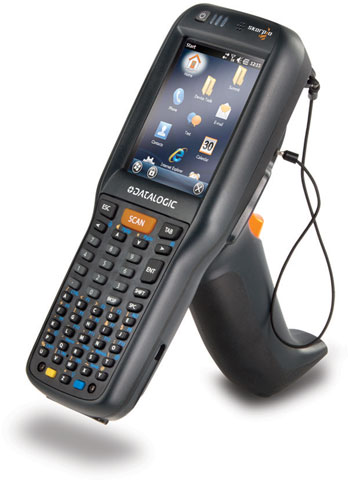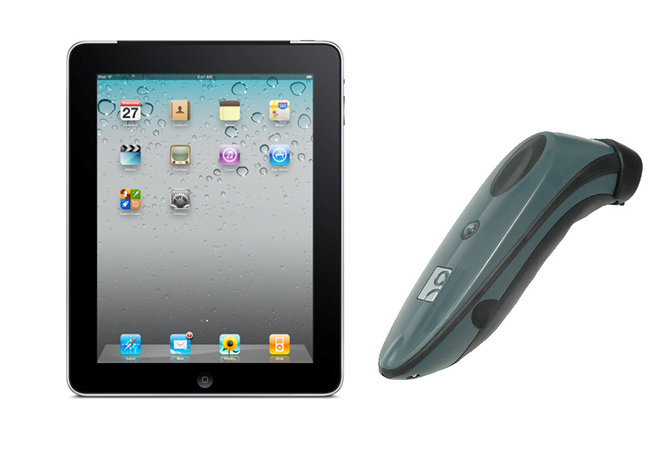Exact Color Matching With the CognitiveTPG Advantage LX and Barcodes.
 Buying paint used to the first difficult step in painting a new room or home. Even after you’ve decided on the color to buy, inevitably you need to buy more paint to match that color.
Buying paint used to the first difficult step in painting a new room or home. Even after you’ve decided on the color to buy, inevitably you need to buy more paint to match that color.
One major US Hardware Chain makes it easy to buy cans of paint with exact color match using the CognitiveTPG Advantage LX printer and barcode labels. With every can of paint mixed, an Ethernet-enabled Advantage LX prints a barcode label containing the pigment mixture used for that paint color. To match a previous color, a customer brings the paint can lid back to the store. The paint department scans the barcode label on the lid, and the terminal displays the paint mixture for the perfect color match.
REWE Chooses Datalogic’s Elf PDA for Their Mobile Data Collection Needs

When REWE identified the need to improve their mobile data communications throughout their various locations; they turned to the Datalogic Elf PDA. The Elf PDA transmits information on items, prices, shelf replenishment and inventory automatically and in real-time with the REWE systems.
The REWE Group looks towards maximizing speed and optimizing the store management in its branches by the end of the year through the implementation of the 8500 Elf PDA units, worth several million Euro. The initial installation of these units is transmitting various amounts of data between the branches and the central information center of REWE via radio communications. By choosing the Datalogic Elf PDA, REWE has invested in a technological, ergonomic and sustainable solution.
Eurotuin Chooses Sato’s GL4e Printers For Shop Automation

Eurotuin, a company comprising of several garden centers in Belgium is a member of Garden Retail Services, the largest full service organisation for garden centers in the Benelux region, with nearly 300 garden centers in the Netherlands and Belgium. Eurotuin recently changed its labeling system and chose NedFox’s RetailVista software to update its shop automation.
Nedfox, a leading retail software vendor specializing in providing cost-effective, scalable software, has chosen to apply SATO’s GL4e printer to its RetailVista ERP software as it has the flexibility and scalability to meet the needs and growth of garden center businesses. NedFox’s software is able to process large amounts of data using barcodes which include information such as prices, available stock in-store, customer database or products’ descriptions. NedFox’s RetailVista ERP is compatible with SATO’s GL4e series printers which are particularly suited to the retail environment thanks to its versatility and online barcode verification and are RFID Ready, therefore fitting perfectly into the Garden Retail Services shop automation.
JD Sports Fashion Finds Their Mobile Computing Solution With The Datalogic Skorpio

JD Sports Fashion is the UK’s number one specialist retailer of both branded and own-brand sports and fashion wear for the entire family. Established in 1981, JD Sports Fashion has grown rapidly to over 400 stores across the UK and the Republic of Ireland. JD’s growth since being listed on the UK Stock Market in 1996 has been meteoric, with the acquisition and consolidation of Scotts and Bank Fashion. Currently, over 1,300 Skorpio mobile computers have been installed in JD Sports Fashion stores across the UK and Ireland.
Datalogic ADC has been a long established partner of JD Sports Fashion since the introduction of over 400 rugged mobile computers for use in JD’s Distribution Centers since 2002. At that time, JD did not have any store management devices. When the decision came to look at automating store operations, JD turned to Datalogic to recommend an appropriate mobile device and solution.
Zoom Room Improves Customer Service with Apple iPad and Socket Barcode Scanners
 Every type of business is concerned with providing the best possible experience for their customers and taking advantage of new technology tools is a great way to do so. Utilizing mobile devices like the Apple iPad and Socket Bluetooth scanners can make any application more efficient and customer friendly.
Every type of business is concerned with providing the best possible experience for their customers and taking advantage of new technology tools is a great way to do so. Utilizing mobile devices like the Apple iPad and Socket Bluetooth scanners can make any application more efficient and customer friendly.
Zoom Room, a chain of dog agility training centers, delivers top-notch customer service for canines and humans alike with the Apple iPad and CHS Series 7 barcode scanners from Socket Mobile. The mobile technology enables employees to spend more time helping customers, perform transactions and registrations away from the front desk, and minimize paper usage to support corporate green initiatives.
Just the Ticket – Sand Springs Police Department Increases Productivity and Safety with the Intermec CN50

To serve and protect is just one of the many things the Sand Springs Police Department (SSPD) is tasked with on a daily basis. As the department’s officers report to work each day, citations are just one of the many ways they keep their population of 19,000 safe. But beyond safety, citations are also a way the city generates revenue.
Previously relying on an outdated manual process, officers would complete a hand-written five-carbon copy citation. The violator would get one copy, and the rest would be distributed to various police, court and city personnel for repeated entry into multiple other computer systems. This process caused a lot of redundancy, administrative time and wasted effort, as citations were often lost in the shuffle or dismissed due to illegibility – causing citation revenue to go uncollected.
In short, SSPD looked for a technology solution that would offer increased officer productivity and an improvement in officer safety by getting them off the roadside faster.
The answer? An eCitation solution coupled with the Intermec CN50 rugged handheld mobile computers.
Continue reading »
Fargo HDP5000 Card Printer at Work With Action Ambulance Services

Action Ambulance services uses Fargo HDP5000 card printer/encoder with lamination for ID, Security and Marketing
The challengeÂ
Action Ambulance Services provides 24-hour emergency and non-emergency medical services to the people of Eastern Massachusetts from 13 different locations. The identification cards worn by emergency personnel face challenging conditions, not only from temperature extremes and inclement weather, but also from bodily fluids, including blood, of patients being treated.
Twelve years ago, the organization began using ID cards for employee identification, but its printer was not able to laminate the cards, nor was it fast enough to keep up with the growing business. Mike Woronka, now Chief Executive Officer of Action Ambulance Services, was responsible for bringing the first ID card printer to the organization. He realized it was time for an upgrade of both the hardware and the software.
Datalogic Memor helps Improve the Service Pipeline at Wildkamp

Wildkamp started selling PVC pipes in the Netherlands 40 years ago. Over the years, the company has become a specialist in the production of pipes, tubes and all related products. Customers can also get support and advice for projects in which the creation of tubes, pipes and pavement play a role. This service requires a high level of knowledge and skill on the part of the company’s employees, especially when one considers that the company houses an assortment of 50,000 articles in the distribution center in Coevorden with an average of 7000 articles in each of the more than 40 branches.
Wildkamp had never used an automated system for controlling stock in the past, but with volumes increasing continuously, it decided it was time to turn to automation.
Mobile Shelf Price Auditing for the Retail Environment
Industry Need
Aggressive pricing and promotions drive success in retail, and modern consumers are more price-sensitive than ever. The pressure to act and react quickly in modifying pricing continues to escalate. To meet this demand, today’s retailer needs increasingly efficient ways to implement accurate pricing changes on the retail floor. Only Intermec provides the total package of mobile printers, mobile computers, bar code scanners, and durable media necessary to label products and shelves at the point-of-use—key to improving store efficiency and eliminating costly errors.
When prices change, it is critically important that the price on the shelf matches the price in the computer; when these do not agree, significant problems result. If the charged price is higher, customer satisfaction plummets. If the charged price is lower, profits are lost. As an added consequence, retailers regularly incur fines when pricing accuracy laws are violated.
Printing today is commonly completed in batch mode using a fixed printer located in a back room away from the retail space. These shelf labeling systems separate a batch printing process from the point of labeling, creating the potential for obsolete, inaccurate, or misplaced shelf labels. Additionally, this separation from point-of-use leads to wasted trips and introduces a greater chance of human error in mis-labeling. For all these reasons, mobile label printing is becoming increasingly popular for shelf and product labeling in the retail environment.
Continue reading »
Mobile Medical Sample Labeling
Industry Need
Medical testing provides key information to physicians, serving as a foundational tool for diagnosing patient conditions. Accuracy is critically important; mistakes can lead to undiagnosed illnesses or inappropriate treatments. Current specimen vial labeling methods, however, are error-prone. Handwritten labels are subject to interpretation and manual data errors; labels preprinted at a central station and carried to the patient location introduce the chance for mix-ups. Mobile sample labeling eliminates these opportunities for errors, enhancing patient safety. Printing on Intermec media ensures robust traceability, meeting the application requirements of sample labeling from the point of collection through challenging laboratory conditions.
Automatic identification technologies such as bar coding excel at eliminating human error. Within the high-touch medical environment these systems have steadily improved patient safety. Errors resulting from manual data entry are unacceptable in a diagnostic environment where they can lead to lost samples (increasing time to diagnose and treat) or mistaken patient identities (potentially leading to incorrect diagnosis and course of treatment).
Recognizing the persistence of these errors, the Joint Commission on Accreditation of Healthcare Organizations (JCAHO) has made improving the accuracy of patient identification the first goal of the 2010 National Patient Safety Goals document. This goal requires blood and specimen containers to be labeled in the patient’s presence. Printing sample labels in place and on-demand with ID scanned from the patient’s wristband eliminates multiple points of error, enhancing patient safety.




